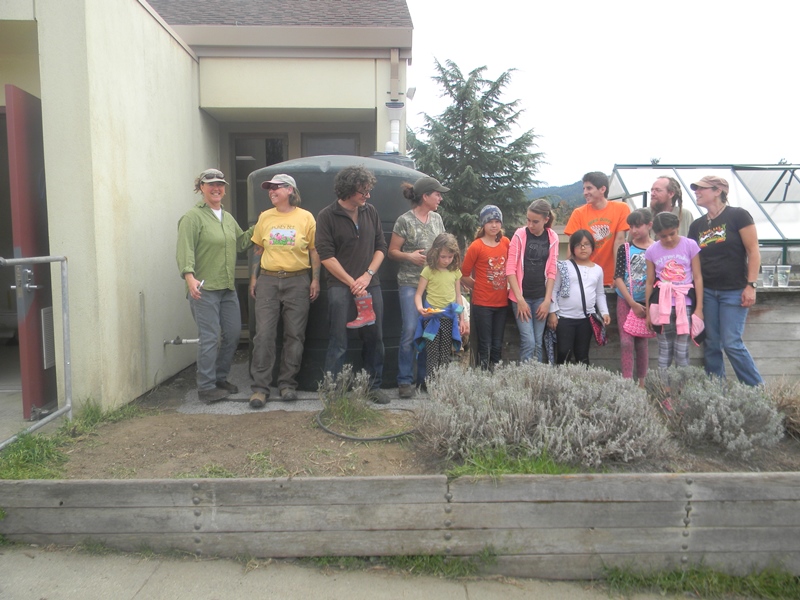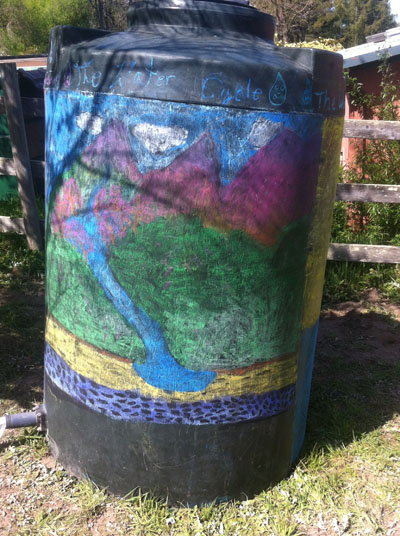
School-sized Rain Catchers are just a larger version of the barrel catchments. The approach is just the same--a rooftop is needed to intercept the rain, and gutters are needed to convey the rain to a storage tank. The tank then needs to have plumbing to direct its stored water to the area on the school where the water will be used, often a garden. Volunteers (students, teachers, and community members) help build the system. Rain Catchers in Your School is a collaborative, environmental education program--we work with students and teachers on a water conservation curriculum, and bring our Water Conservationist into the classroom and onto the school site for a community outreach ":Build It" day.
Preliminary steps involve working closely with the school and educators to determine the best place of a "Rain Catcher" system, which classrooms will be involved, and what day is best to host a workshop. The NCRC&DC provides all of the materials and helps guide the outreach for a learning opportunity that carries the water conservation message from the classroom home to the family, then outward to others with our Learn-And-Tell model of youth engagement.
The design steps include:
• Evaluate the site and determine best location for a rooftop system, including storage tank and overflow discharge area
• Design the system (using student involvement wherever practicable)
o Size all components of the system correctly (excellent real world application of geometry and algebra for high school projects)
o survey the topography of the location for appropriate gravity-drainage feed and discharge lines, ensuring the slope is properly designed and managed
o Determine use of the stored water, and mechanism for conveyance to the use area
• Develop the schematics and parts list
• Obtain any needed permits or approvals
• Purchase the parts
• Install the system with the help of students and parents
If this is your school, start a Workgroup who will conduct a complete site assessment to determine best location for a rooftop system, including storage tank and overflow discharge area. Rough dimensions of rooftop area for collection should be estimated, and rough tank sizes should be determined, along with the plan for use of the stored rain water, and any overflow water from a storage tank. Consideration should be given to the disposition of excess water that overflows the collection tank during large rain events. (note: The potential for backflow can be prevented by leaving a physical air gap between the potable water supply outlet and the potentially contaminated water or by installing anti-siphon devices such as double check valves or vacuum breakers.).
The System can be collaboratively designed with the workgroup providing needed engineering and surveying work to properly design the system (using student involvement wherever practicable). Specifically, all gutters and conveyance systems will need to be properly sized for the anticipated maximum flow for a design rain event, and the layout/topography will be appropriately surveyed to utilize gravity flow for all components both to the storage system, and from the storage system to the ultimate use area.
First-flush diverters may be useful to remove the first flush of water after runoff begins. Leaf screens may be useful to keep debris out of the collected water; such screens will need maintenance to prevent clogging as they collect leaves and other debris
Depending on location, local conditions, and materials used, tanks and their plumbing may not need any special preparations for winter weather. Valves may need testing the following spring as they are susceptible to damage by freezing water.
It is important to know the local regulations. In all cases, building codes, health department stipulations and water supply company requirements should be followed to prevent cross connection. Obtaining permits, using certified plumbers, or allowing inspections of completed installations may be required.
A drawn schematic of the design should be prepared, and a parts list developed for the planned design. Once any needed permits are obtained, the pats will be purchased, seeking donations or reduced costs/discounts wherever possible.
A day for installation will be selected and volunteers should be recruited from the school, partnering agencies, parents and students. The tank bed may be installed on a day prior to the installation of the tank and conveyance system.




